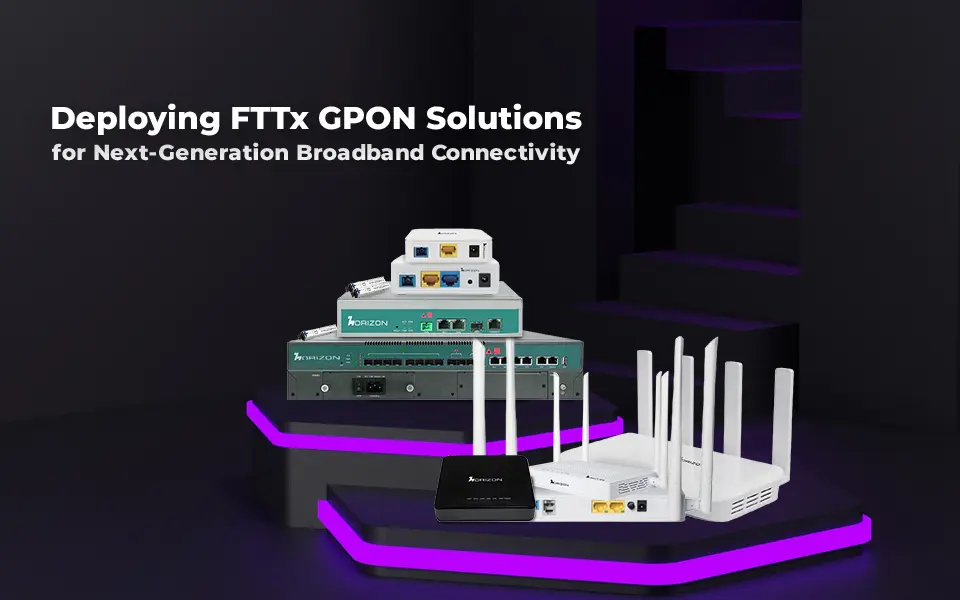A Case Study: Deploying FTTx GPON Solutions for Next-Generation Broadband Connectivity
The surge in demand for high-speed broadband connectivity has been propelled by the increasing reliance on digital services, remote work arrangements, online education platforms and the widespread trend of streaming entertainment content.
Within the realm of solutions catering to this demand, Fiber-to-the-x (FTTx) options have emerged as pivotal players, with a spotlight on the efficacy of Gigabit Passive Optical Network (GPON) technology. This case study takes a deep dive into the practical application of FTTx GPON solutions, illuminating their array of benefits, navigating through challenges, and examining the constructive influence they wield over user experience enhancement and the revenue augmentation of service providers.

Introduction:
In the face of growing data consumption and the need for reliable high-speed internet access, traditional copper-based networks have proven inadequate. FTTx solutions, which bring fiber optic cables closer to end-users, have emerged as the solution of choice to provide Gigabit-speed connectivity. Among the FTTx technologies, GPON stands out for its cost-effectiveness, scalability, and ability to serve both residential and business customers.

The Problem
A regional telecommunications company was facing several challenges with their existing broadband infrastructure. Their legacy copper-based network struggled to deliver consistent high-speed connections to subscribers. As user demand continued to rise, the company experienced network congestion during peak hours, leading to customer dissatisfaction and churn. Recognizing the need for a modernized solution, they decided to explore FTTx GPON technology.
Solution
After careful evaluation, the company chose to implement a GPON-based FTTx solution to address their network woes. The solution involved deploying fiber optic cables from their central office (CO) to neighborhood distribution points, and from there, using passive optical splitters to deliver the connection to individual subscribers. The network architecture comprised Optical Line Terminals (OLTs) at the CO, Optical Network Units (ONUs) at subscriber premises, and passive optical splitters in between.
Benefits
1. High-Speed Connectivity: GPON technology offers symmetrical Gigabit-speed connections, ensuring a seamless and lag-free online experience for users. This high-speed connectivity is vital for video conferencing, online gaming, 4K streaming, and other data-intensive applications.
2. Scalability: GPON networks can easily scale to accommodate more subscribers without significant changes to the infrastructure. As demand grows, additional ONUs can be added to the network with minimal disruption.
3. Shared Bandwidth: GPON’s shared bandwidth architecture allows service providers to efficiently allocate resources based on user demand. This dynamic allocation ensures that bandwidth is distributed optimally, reducing congestion during peak hours.
4. Cost-Efficiency: Fiber optics are becoming more affordable, and the passive nature of GPON networks reduces the need for active components, minimizing power consumption and operational costs.
5. Future-Proofing: Fiber optic infrastructure is capable of supporting future technological advancements and higher data rates, providing a long-term solution that can adapt to evolving user needs.

Deployment Process
Network Planning: The company initiated the deployment by conducting a thorough network assessment and planning phase. This involved analyzing the geographical layout, identifying optimal distribution points, and designing the network architecture.
Infrastructure Installation: Fiber optic cables were laid from the CO to distribution points using trenching or overhead installations. Careful consideration was given to route planning to minimize disruptions and ensure future maintenance ease.
See our GPON Devices here.
Splitter Installation: Passive optical splitters were strategically placed at distribution points to split the optical signal and route it to individual subscribers. These splitters require no power and have no active electronic components, enhancing network reliability.
Subscriber Connection: ONUs were installed at subscriber premises. These devices convert the optical signal back to electrical signals for user devices to access the internet. The connection was established using Ethernet or Wi-Fi, depending on the subscriber’s preference.
Testing and Optimization: The deployed network underwent rigorous testing to ensure signal quality, bandwidth allocation, and connection stability. Any issues were promptly addressed and optimized to guarantee a seamless user experience.
Challenges
While the deployment of FTTx GPON solutions offers numerous benefits, it comes with its own set of challenges:
Initial Investment: The upfront cost of deploying fiber optic infrastructure can be significant. However, they weighed this against the long-term benefits and return on investment.
Deployment Time: Installing fiber optic cables and network components requires time and careful planning. Balancing the need for quick deployment with network quality was essential.
Subscriber Education: Subscribers needed to understand the benefits of the new technology and any changes in equipment at their premises. Effective communication was crucial to mitigate confusion.
Maintenance and Repairs: While fiber optics are more durable than copper, they still require proper maintenance. Regular inspections and repairs, if necessary, were incorporated into the maintenance plan.
Results and Impact
The company’s decision to deploy FTTx GPON solutions led to significant improvements in their network performance and customer satisfaction. Users experienced a substantial increase in download and upload speeds, enabling them to seamlessly engage in bandwidth-intensive activities. The shared bandwidth architecture of GPON also reduced network congestion during peak hours, resulting in consistent performance across the board.
Moreover, the deployment positively impacted their revenue. The improved service quality attracted new subscribers and encouraged existing customers to upgrade their plans, resulting in increased average revenue per user (ARPU). The scalability of the GPON network allowed them to easily accommodate the growing user base without major infrastructure overhauls.
Conclusion:
This case study of the company’s deployment of FTTx GPON solutions illustrates the transformative power of fiber optic technology in modernizing broadband networks. The benefits of high-speed connectivity, scalability, and cost-efficiency are substantial and can have a lasting positive impact on both service providers and end-users. While challenges exist, careful planning, effective communication and proactive maintenance can overcome these obstacles. As the digital landscape continues to evolve, FTTx GPON solutions offer a robust framework for delivering the next generation of broadband connectivity.








